Detailed Analysis of Business Environment Factors: Sainsbury's Report
VerifiedAdded on 2023/01/13
|17
|4118
|27
Report
AI Summary
This report provides a comprehensive analysis of Sainsbury's business environment, examining different types, sizes, and scopes of organizations, including profit, non-profit, and government entities. It explores the interrelationship of various functions within an organization, such as finance, marketing, and human resources, and their impact on business objectives. The report delves into macro environmental factors, including political, economic, and social aspects, and their positive and negative impacts on Sainsbury's. Furthermore, it evaluates the internal strengths and weaknesses of the business in relation to external macro factors, offering insights into the company's operations and challenges. The report concludes with an overview of the global growth and development of transactional, international, and global organizations and their relevance to Sainsbury's and the broader business landscape.
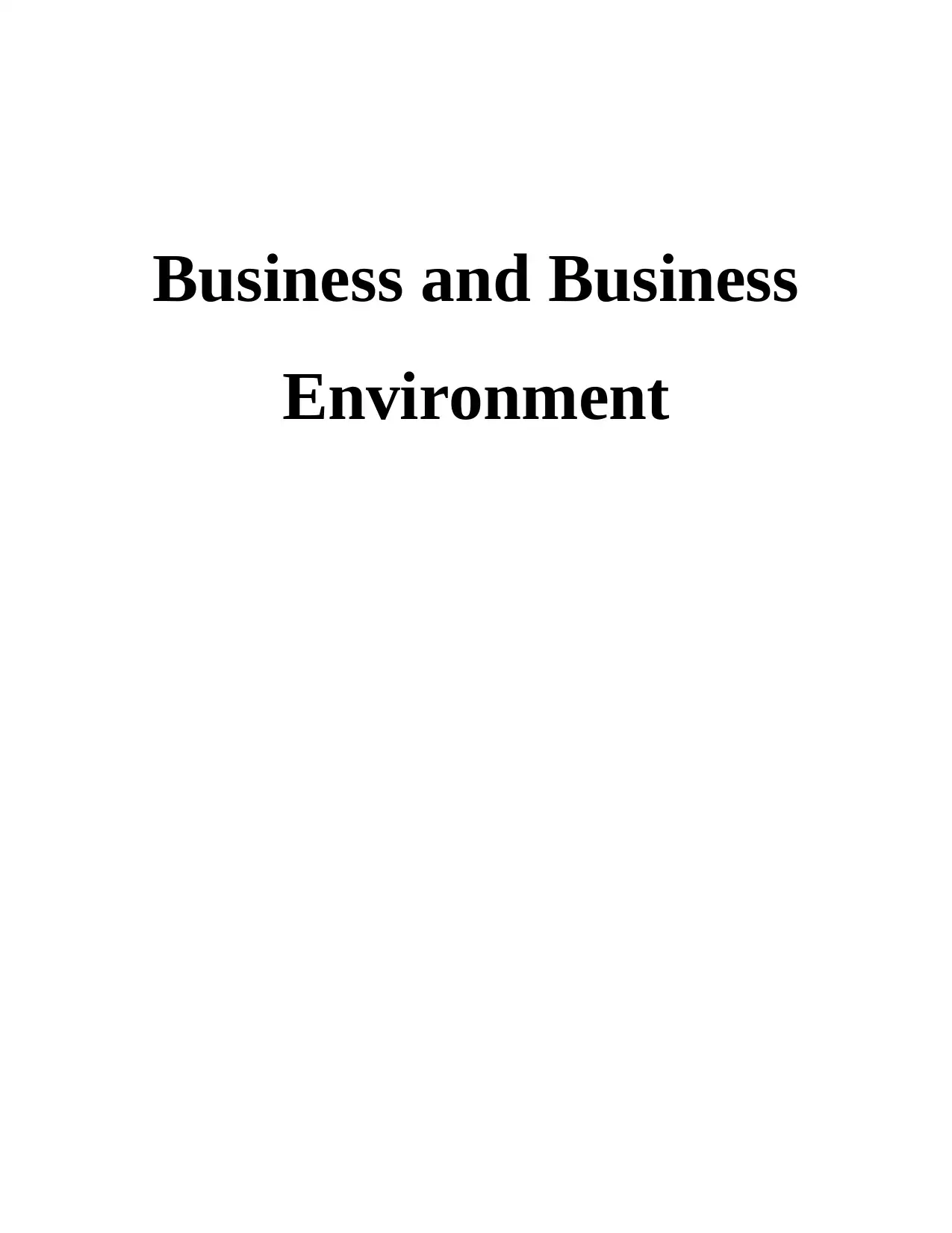
Business and Business
Environment
Environment
Paraphrase This Document
Need a fresh take? Get an instant paraphrase of this document with our AI Paraphraser
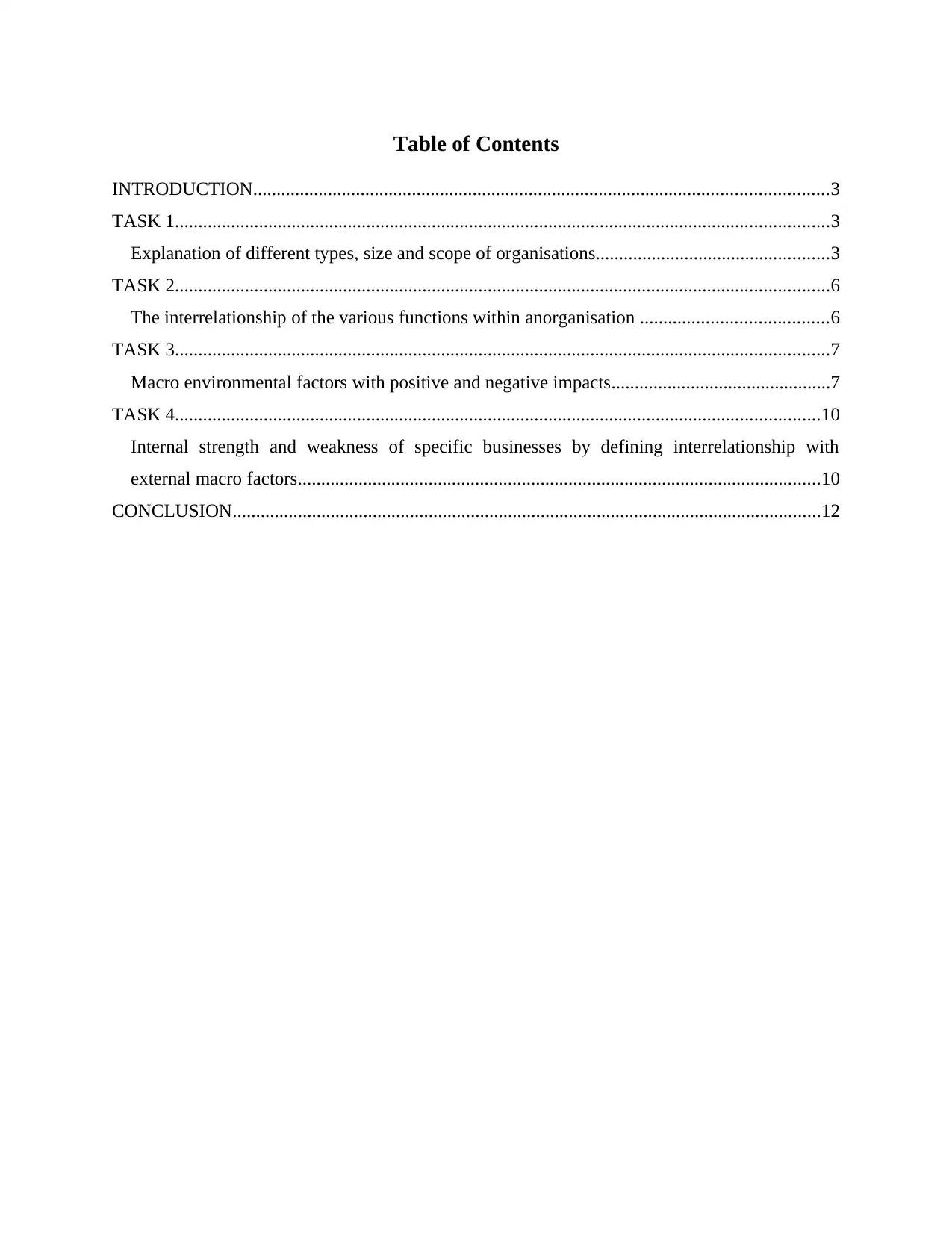
Table of Contents
INTRODUCTION...........................................................................................................................3
TASK 1............................................................................................................................................3
Explanation of different types, size and scope of organisations..................................................3
TASK 2............................................................................................................................................6
The interrelationship of the various functions within anorganisation ........................................6
TASK 3............................................................................................................................................7
Macro environmental factors with positive and negative impacts...............................................7
TASK 4..........................................................................................................................................10
Internal strength and weakness of specific businesses by defining interrelationship with
external macro factors................................................................................................................10
CONCLUSION..............................................................................................................................12
INTRODUCTION...........................................................................................................................3
TASK 1............................................................................................................................................3
Explanation of different types, size and scope of organisations..................................................3
TASK 2............................................................................................................................................6
The interrelationship of the various functions within anorganisation ........................................6
TASK 3............................................................................................................................................7
Macro environmental factors with positive and negative impacts...............................................7
TASK 4..........................................................................................................................................10
Internal strength and weakness of specific businesses by defining interrelationship with
external macro factors................................................................................................................10
CONCLUSION..............................................................................................................................12

⊘ This is a preview!⊘
Do you want full access?
Subscribe today to unlock all pages.

Trusted by 1+ million students worldwide
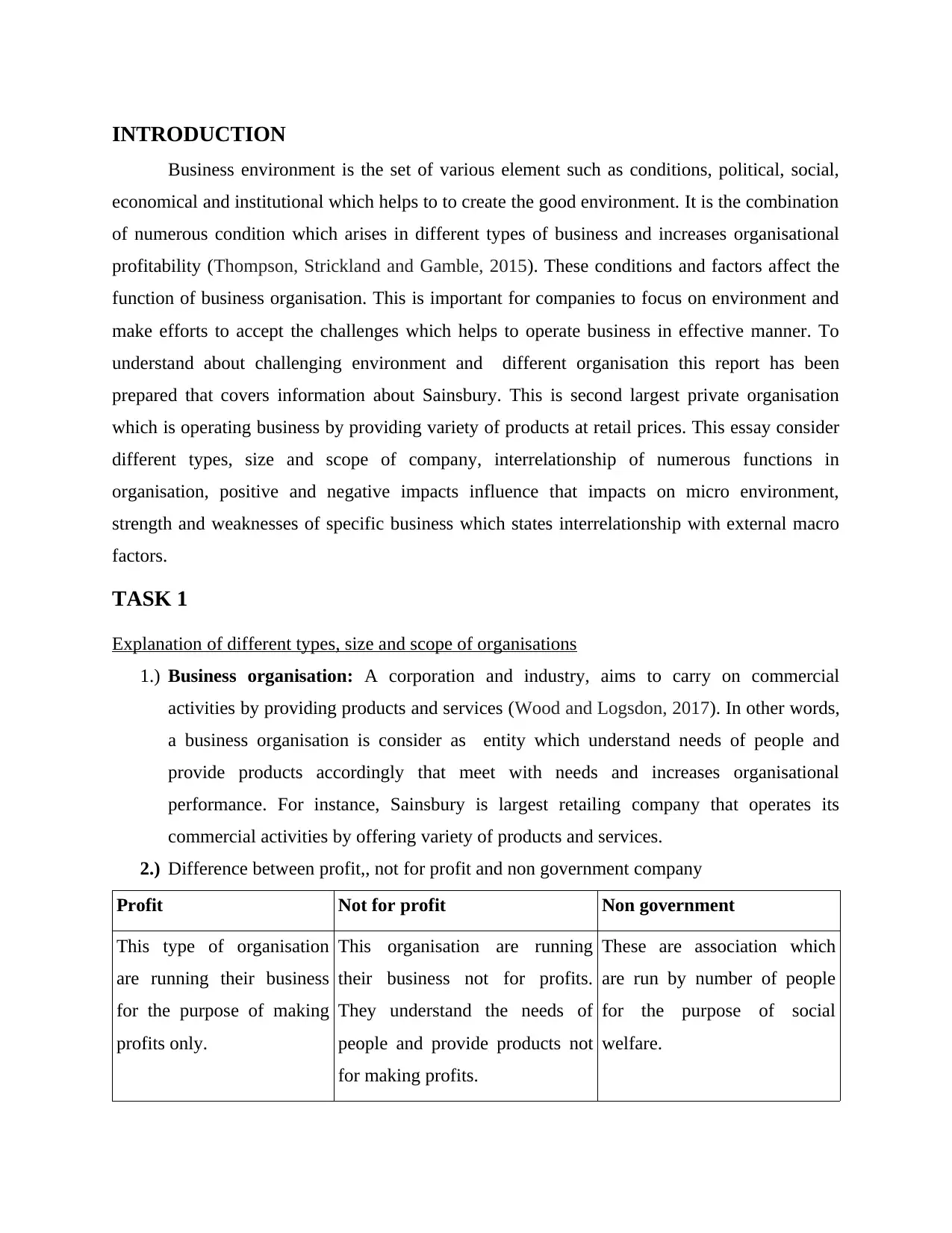
INTRODUCTION
Business environment is the set of various element such as conditions, political, social,
economical and institutional which helps to to create the good environment. It is the combination
of numerous condition which arises in different types of business and increases organisational
profitability (Thompson, Strickland and Gamble, 2015). These conditions and factors affect the
function of business organisation. This is important for companies to focus on environment and
make efforts to accept the challenges which helps to operate business in effective manner. To
understand about challenging environment and different organisation this report has been
prepared that covers information about Sainsbury. This is second largest private organisation
which is operating business by providing variety of products at retail prices. This essay consider
different types, size and scope of company, interrelationship of numerous functions in
organisation, positive and negative impacts influence that impacts on micro environment,
strength and weaknesses of specific business which states interrelationship with external macro
factors.
TASK 1
Explanation of different types, size and scope of organisations
1.) Business organisation: A corporation and industry, aims to carry on commercial
activities by providing products and services (Wood and Logsdon, 2017). In other words,
a business organisation is consider as entity which understand needs of people and
provide products accordingly that meet with needs and increases organisational
performance. For instance, Sainsbury is largest retailing company that operates its
commercial activities by offering variety of products and services.
2.) Difference between profit,, not for profit and non government company
Profit Not for profit Non government
This type of organisation
are running their business
for the purpose of making
profits only.
This organisation are running
their business not for profits.
They understand the needs of
people and provide products not
for making profits.
These are association which
are run by number of people
for the purpose of social
welfare.
Business environment is the set of various element such as conditions, political, social,
economical and institutional which helps to to create the good environment. It is the combination
of numerous condition which arises in different types of business and increases organisational
profitability (Thompson, Strickland and Gamble, 2015). These conditions and factors affect the
function of business organisation. This is important for companies to focus on environment and
make efforts to accept the challenges which helps to operate business in effective manner. To
understand about challenging environment and different organisation this report has been
prepared that covers information about Sainsbury. This is second largest private organisation
which is operating business by providing variety of products at retail prices. This essay consider
different types, size and scope of company, interrelationship of numerous functions in
organisation, positive and negative impacts influence that impacts on micro environment,
strength and weaknesses of specific business which states interrelationship with external macro
factors.
TASK 1
Explanation of different types, size and scope of organisations
1.) Business organisation: A corporation and industry, aims to carry on commercial
activities by providing products and services (Wood and Logsdon, 2017). In other words,
a business organisation is consider as entity which understand needs of people and
provide products accordingly that meet with needs and increases organisational
performance. For instance, Sainsbury is largest retailing company that operates its
commercial activities by offering variety of products and services.
2.) Difference between profit,, not for profit and non government company
Profit Not for profit Non government
This type of organisation
are running their business
for the purpose of making
profits only.
This organisation are running
their business not for profits.
They understand the needs of
people and provide products not
for making profits.
These are association which
are run by number of people
for the purpose of social
welfare.
Paraphrase This Document
Need a fresh take? Get an instant paraphrase of this document with our AI Paraphraser
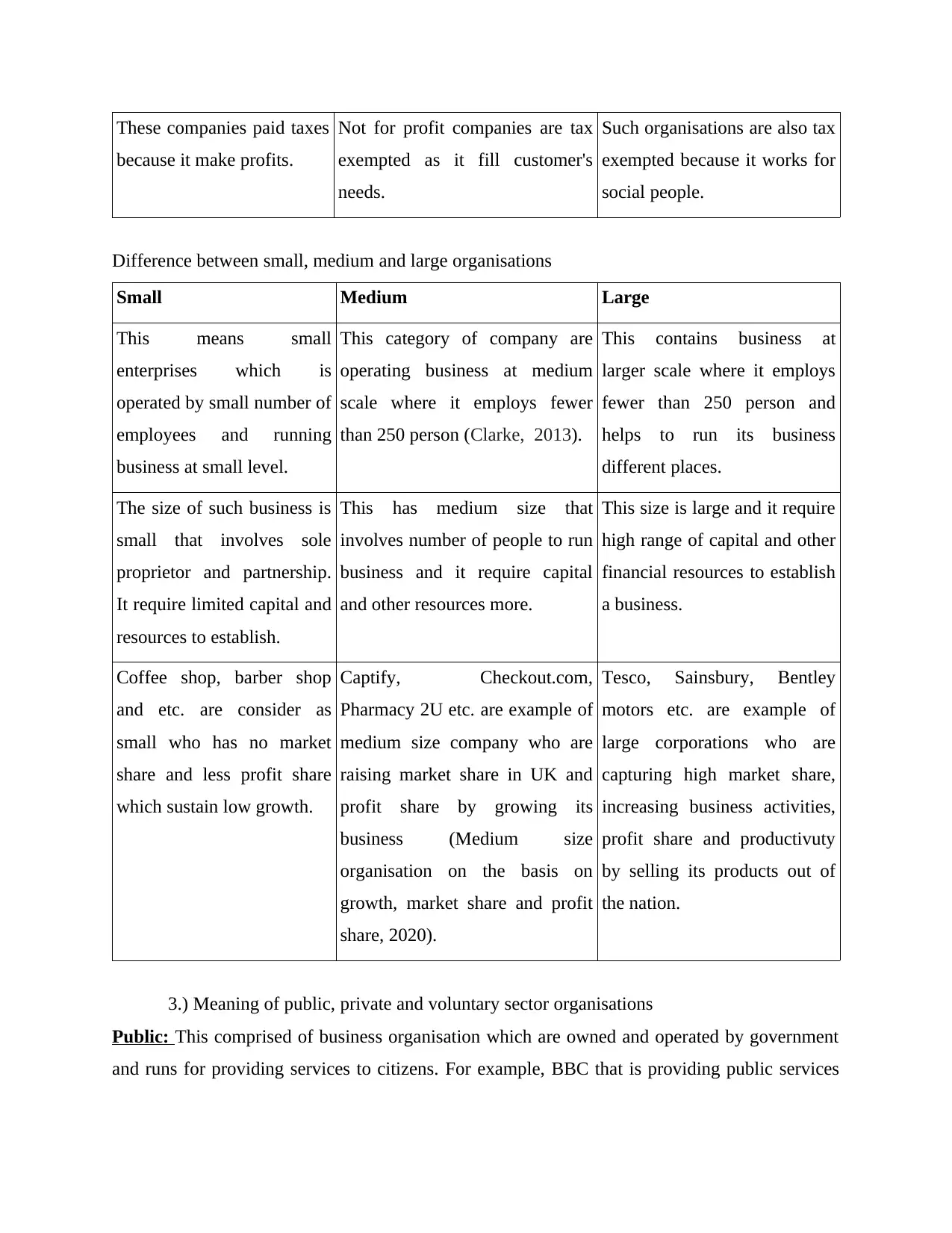
These companies paid taxes
because it make profits.
Not for profit companies are tax
exempted as it fill customer's
needs.
Such organisations are also tax
exempted because it works for
social people.
Difference between small, medium and large organisations
Small Medium Large
This means small
enterprises which is
operated by small number of
employees and running
business at small level.
This category of company are
operating business at medium
scale where it employs fewer
than 250 person (Clarke, 2013).
This contains business at
larger scale where it employs
fewer than 250 person and
helps to run its business
different places.
The size of such business is
small that involves sole
proprietor and partnership.
It require limited capital and
resources to establish.
This has medium size that
involves number of people to run
business and it require capital
and other resources more.
This size is large and it require
high range of capital and other
financial resources to establish
a business.
Coffee shop, barber shop
and etc. are consider as
small who has no market
share and less profit share
which sustain low growth.
Captify, Checkout.com,
Pharmacy 2U etc. are example of
medium size company who are
raising market share in UK and
profit share by growing its
business (Medium size
organisation on the basis on
growth, market share and profit
share, 2020).
Tesco, Sainsbury, Bentley
motors etc. are example of
large corporations who are
capturing high market share,
increasing business activities,
profit share and productivuty
by selling its products out of
the nation.
3.) Meaning of public, private and voluntary sector organisations
Public: This comprised of business organisation which are owned and operated by government
and runs for providing services to citizens. For example, BBC that is providing public services
because it make profits.
Not for profit companies are tax
exempted as it fill customer's
needs.
Such organisations are also tax
exempted because it works for
social people.
Difference between small, medium and large organisations
Small Medium Large
This means small
enterprises which is
operated by small number of
employees and running
business at small level.
This category of company are
operating business at medium
scale where it employs fewer
than 250 person (Clarke, 2013).
This contains business at
larger scale where it employs
fewer than 250 person and
helps to run its business
different places.
The size of such business is
small that involves sole
proprietor and partnership.
It require limited capital and
resources to establish.
This has medium size that
involves number of people to run
business and it require capital
and other resources more.
This size is large and it require
high range of capital and other
financial resources to establish
a business.
Coffee shop, barber shop
and etc. are consider as
small who has no market
share and less profit share
which sustain low growth.
Captify, Checkout.com,
Pharmacy 2U etc. are example of
medium size company who are
raising market share in UK and
profit share by growing its
business (Medium size
organisation on the basis on
growth, market share and profit
share, 2020).
Tesco, Sainsbury, Bentley
motors etc. are example of
large corporations who are
capturing high market share,
increasing business activities,
profit share and productivuty
by selling its products out of
the nation.
3.) Meaning of public, private and voluntary sector organisations
Public: This comprised of business organisation which are owned and operated by government
and runs for providing services to citizens. For example, BBC that is providing public services
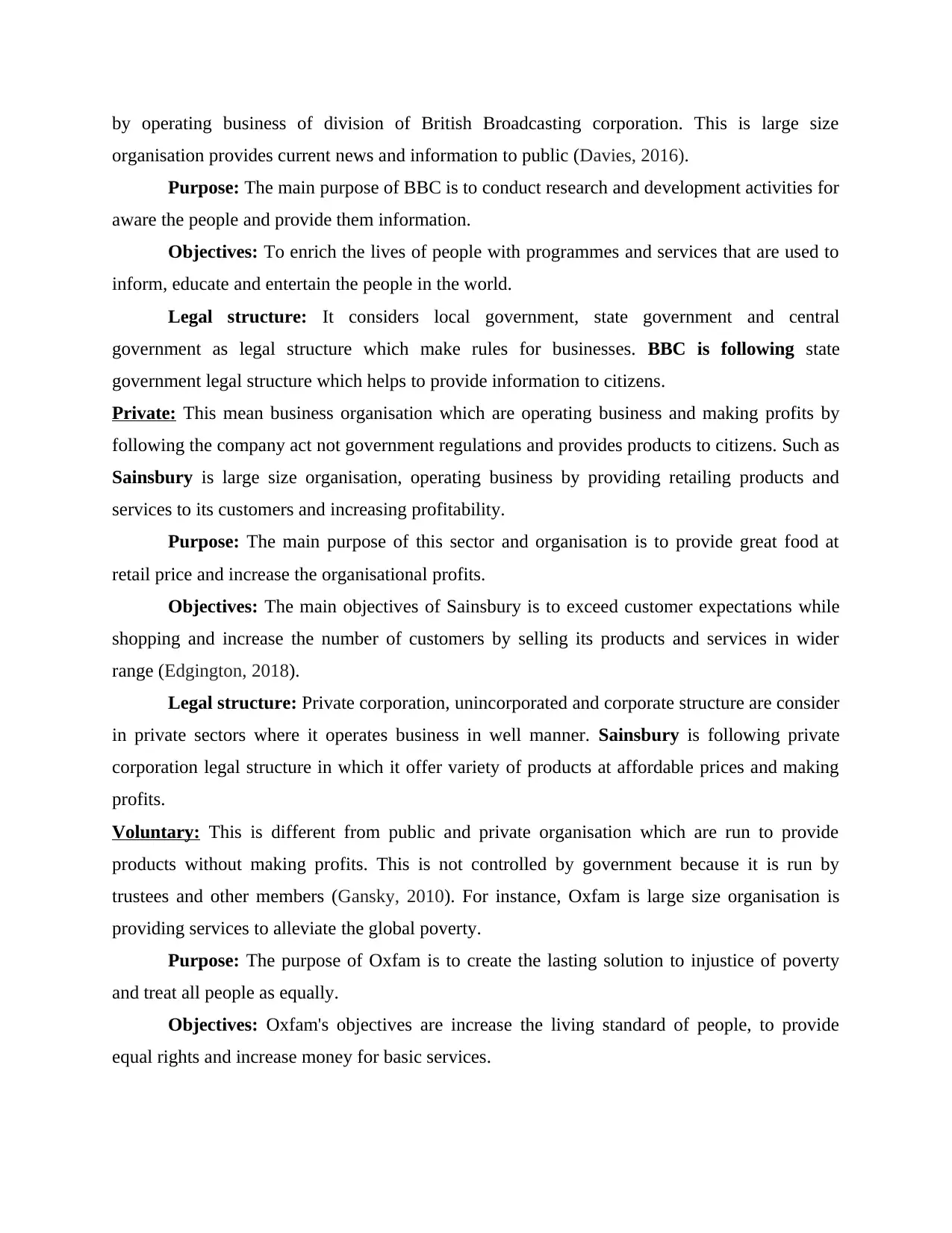
by operating business of division of British Broadcasting corporation. This is large size
organisation provides current news and information to public (Davies, 2016).
Purpose: The main purpose of BBC is to conduct research and development activities for
aware the people and provide them information.
Objectives: To enrich the lives of people with programmes and services that are used to
inform, educate and entertain the people in the world.
Legal structure: It considers local government, state government and central
government as legal structure which make rules for businesses. BBC is following state
government legal structure which helps to provide information to citizens.
Private: This mean business organisation which are operating business and making profits by
following the company act not government regulations and provides products to citizens. Such as
Sainsbury is large size organisation, operating business by providing retailing products and
services to its customers and increasing profitability.
Purpose: The main purpose of this sector and organisation is to provide great food at
retail price and increase the organisational profits.
Objectives: The main objectives of Sainsbury is to exceed customer expectations while
shopping and increase the number of customers by selling its products and services in wider
range (Edgington, 2018).
Legal structure: Private corporation, unincorporated and corporate structure are consider
in private sectors where it operates business in well manner. Sainsbury is following private
corporation legal structure in which it offer variety of products at affordable prices and making
profits.
Voluntary: This is different from public and private organisation which are run to provide
products without making profits. This is not controlled by government because it is run by
trustees and other members (Gansky, 2010). For instance, Oxfam is large size organisation is
providing services to alleviate the global poverty.
Purpose: The purpose of Oxfam is to create the lasting solution to injustice of poverty
and treat all people as equally.
Objectives: Oxfam's objectives are increase the living standard of people, to provide
equal rights and increase money for basic services.
organisation provides current news and information to public (Davies, 2016).
Purpose: The main purpose of BBC is to conduct research and development activities for
aware the people and provide them information.
Objectives: To enrich the lives of people with programmes and services that are used to
inform, educate and entertain the people in the world.
Legal structure: It considers local government, state government and central
government as legal structure which make rules for businesses. BBC is following state
government legal structure which helps to provide information to citizens.
Private: This mean business organisation which are operating business and making profits by
following the company act not government regulations and provides products to citizens. Such as
Sainsbury is large size organisation, operating business by providing retailing products and
services to its customers and increasing profitability.
Purpose: The main purpose of this sector and organisation is to provide great food at
retail price and increase the organisational profits.
Objectives: The main objectives of Sainsbury is to exceed customer expectations while
shopping and increase the number of customers by selling its products and services in wider
range (Edgington, 2018).
Legal structure: Private corporation, unincorporated and corporate structure are consider
in private sectors where it operates business in well manner. Sainsbury is following private
corporation legal structure in which it offer variety of products at affordable prices and making
profits.
Voluntary: This is different from public and private organisation which are run to provide
products without making profits. This is not controlled by government because it is run by
trustees and other members (Gansky, 2010). For instance, Oxfam is large size organisation is
providing services to alleviate the global poverty.
Purpose: The purpose of Oxfam is to create the lasting solution to injustice of poverty
and treat all people as equally.
Objectives: Oxfam's objectives are increase the living standard of people, to provide
equal rights and increase money for basic services.
⊘ This is a preview!⊘
Do you want full access?
Subscribe today to unlock all pages.

Trusted by 1+ million students worldwide
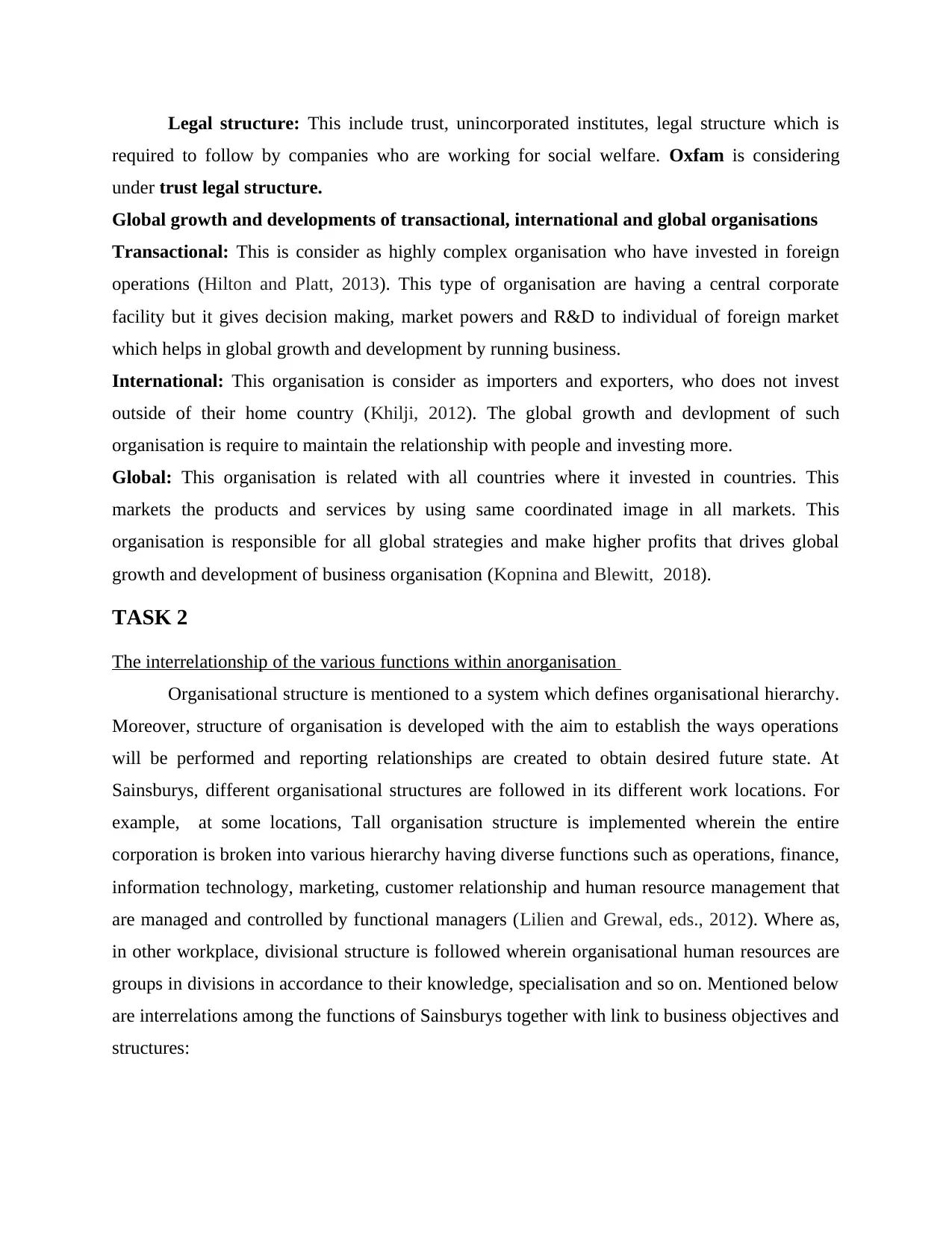
Legal structure: This include trust, unincorporated institutes, legal structure which is
required to follow by companies who are working for social welfare. Oxfam is considering
under trust legal structure.
Global growth and developments of transactional, international and global organisations
Transactional: This is consider as highly complex organisation who have invested in foreign
operations (Hilton and Platt, 2013). This type of organisation are having a central corporate
facility but it gives decision making, market powers and R&D to individual of foreign market
which helps in global growth and development by running business.
International: This organisation is consider as importers and exporters, who does not invest
outside of their home country (Khilji, 2012). The global growth and devlopment of such
organisation is require to maintain the relationship with people and investing more.
Global: This organisation is related with all countries where it invested in countries. This
markets the products and services by using same coordinated image in all markets. This
organisation is responsible for all global strategies and make higher profits that drives global
growth and development of business organisation (Kopnina and Blewitt, 2018).
TASK 2
The interrelationship of the various functions within anorganisation
Organisational structure is mentioned to a system which defines organisational hierarchy.
Moreover, structure of organisation is developed with the aim to establish the ways operations
will be performed and reporting relationships are created to obtain desired future state. At
Sainsburys, different organisational structures are followed in its different work locations. For
example, at some locations, Tall organisation structure is implemented wherein the entire
corporation is broken into various hierarchy having diverse functions such as operations, finance,
information technology, marketing, customer relationship and human resource management that
are managed and controlled by functional managers (Lilien and Grewal, eds., 2012). Where as,
in other workplace, divisional structure is followed wherein organisational human resources are
groups in divisions in accordance to their knowledge, specialisation and so on. Mentioned below
are interrelations among the functions of Sainsburys together with link to business objectives and
structures:
required to follow by companies who are working for social welfare. Oxfam is considering
under trust legal structure.
Global growth and developments of transactional, international and global organisations
Transactional: This is consider as highly complex organisation who have invested in foreign
operations (Hilton and Platt, 2013). This type of organisation are having a central corporate
facility but it gives decision making, market powers and R&D to individual of foreign market
which helps in global growth and development by running business.
International: This organisation is consider as importers and exporters, who does not invest
outside of their home country (Khilji, 2012). The global growth and devlopment of such
organisation is require to maintain the relationship with people and investing more.
Global: This organisation is related with all countries where it invested in countries. This
markets the products and services by using same coordinated image in all markets. This
organisation is responsible for all global strategies and make higher profits that drives global
growth and development of business organisation (Kopnina and Blewitt, 2018).
TASK 2
The interrelationship of the various functions within anorganisation
Organisational structure is mentioned to a system which defines organisational hierarchy.
Moreover, structure of organisation is developed with the aim to establish the ways operations
will be performed and reporting relationships are created to obtain desired future state. At
Sainsburys, different organisational structures are followed in its different work locations. For
example, at some locations, Tall organisation structure is implemented wherein the entire
corporation is broken into various hierarchy having diverse functions such as operations, finance,
information technology, marketing, customer relationship and human resource management that
are managed and controlled by functional managers (Lilien and Grewal, eds., 2012). Where as,
in other workplace, divisional structure is followed wherein organisational human resources are
groups in divisions in accordance to their knowledge, specialisation and so on. Mentioned below
are interrelations among the functions of Sainsburys together with link to business objectives and
structures:
Paraphrase This Document
Need a fresh take? Get an instant paraphrase of this document with our AI Paraphraser
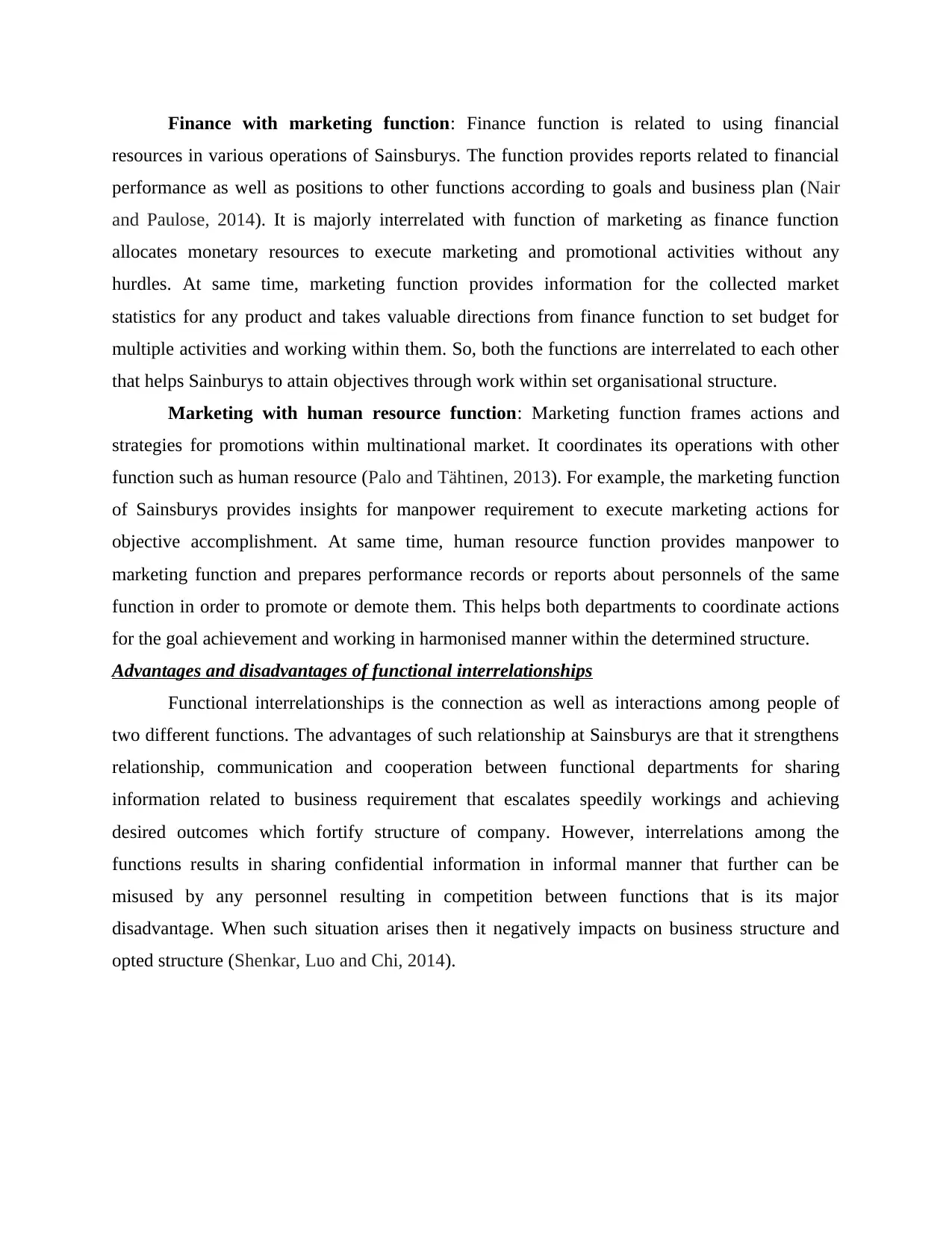
Finance with marketing function: Finance function is related to using financial
resources in various operations of Sainsburys. The function provides reports related to financial
performance as well as positions to other functions according to goals and business plan (Nair
and Paulose, 2014). It is majorly interrelated with function of marketing as finance function
allocates monetary resources to execute marketing and promotional activities without any
hurdles. At same time, marketing function provides information for the collected market
statistics for any product and takes valuable directions from finance function to set budget for
multiple activities and working within them. So, both the functions are interrelated to each other
that helps Sainburys to attain objectives through work within set organisational structure.
Marketing with human resource function: Marketing function frames actions and
strategies for promotions within multinational market. It coordinates its operations with other
function such as human resource (Palo and Tähtinen, 2013). For example, the marketing function
of Sainsburys provides insights for manpower requirement to execute marketing actions for
objective accomplishment. At same time, human resource function provides manpower to
marketing function and prepares performance records or reports about personnels of the same
function in order to promote or demote them. This helps both departments to coordinate actions
for the goal achievement and working in harmonised manner within the determined structure.
Advantages and disadvantages of functional interrelationships
Functional interrelationships is the connection as well as interactions among people of
two different functions. The advantages of such relationship at Sainsburys are that it strengthens
relationship, communication and cooperation between functional departments for sharing
information related to business requirement that escalates speedily workings and achieving
desired outcomes which fortify structure of company. However, interrelations among the
functions results in sharing confidential information in informal manner that further can be
misused by any personnel resulting in competition between functions that is its major
disadvantage. When such situation arises then it negatively impacts on business structure and
opted structure (Shenkar, Luo and Chi, 2014).
resources in various operations of Sainsburys. The function provides reports related to financial
performance as well as positions to other functions according to goals and business plan (Nair
and Paulose, 2014). It is majorly interrelated with function of marketing as finance function
allocates monetary resources to execute marketing and promotional activities without any
hurdles. At same time, marketing function provides information for the collected market
statistics for any product and takes valuable directions from finance function to set budget for
multiple activities and working within them. So, both the functions are interrelated to each other
that helps Sainburys to attain objectives through work within set organisational structure.
Marketing with human resource function: Marketing function frames actions and
strategies for promotions within multinational market. It coordinates its operations with other
function such as human resource (Palo and Tähtinen, 2013). For example, the marketing function
of Sainsburys provides insights for manpower requirement to execute marketing actions for
objective accomplishment. At same time, human resource function provides manpower to
marketing function and prepares performance records or reports about personnels of the same
function in order to promote or demote them. This helps both departments to coordinate actions
for the goal achievement and working in harmonised manner within the determined structure.
Advantages and disadvantages of functional interrelationships
Functional interrelationships is the connection as well as interactions among people of
two different functions. The advantages of such relationship at Sainsburys are that it strengthens
relationship, communication and cooperation between functional departments for sharing
information related to business requirement that escalates speedily workings and achieving
desired outcomes which fortify structure of company. However, interrelations among the
functions results in sharing confidential information in informal manner that further can be
misused by any personnel resulting in competition between functions that is its major
disadvantage. When such situation arises then it negatively impacts on business structure and
opted structure (Shenkar, Luo and Chi, 2014).
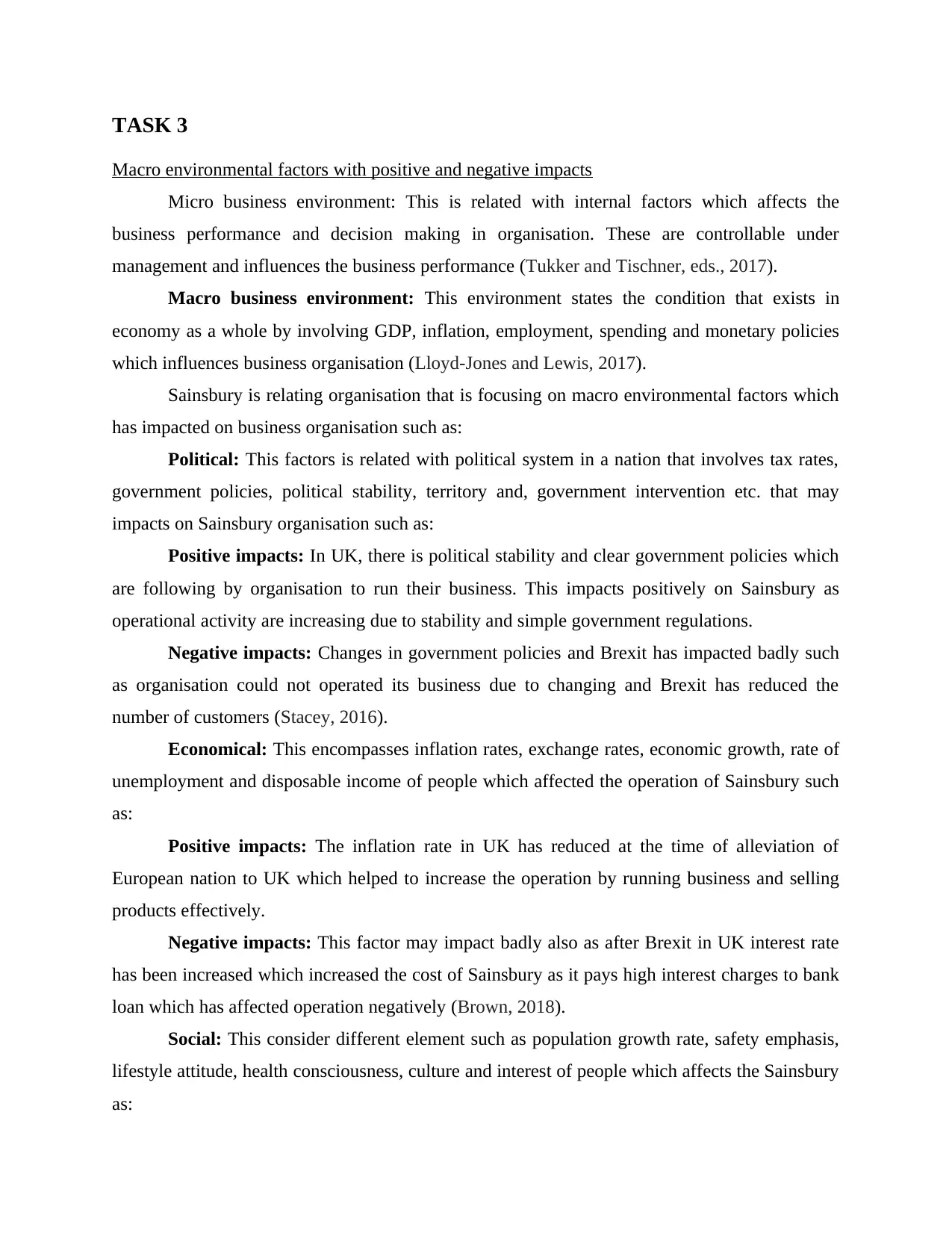
TASK 3
Macro environmental factors with positive and negative impacts
Micro business environment: This is related with internal factors which affects the
business performance and decision making in organisation. These are controllable under
management and influences the business performance (Tukker and Tischner, eds., 2017).
Macro business environment: This environment states the condition that exists in
economy as a whole by involving GDP, inflation, employment, spending and monetary policies
which influences business organisation (Lloyd-Jones and Lewis, 2017).
Sainsbury is relating organisation that is focusing on macro environmental factors which
has impacted on business organisation such as:
Political: This factors is related with political system in a nation that involves tax rates,
government policies, political stability, territory and, government intervention etc. that may
impacts on Sainsbury organisation such as:
Positive impacts: In UK, there is political stability and clear government policies which
are following by organisation to run their business. This impacts positively on Sainsbury as
operational activity are increasing due to stability and simple government regulations.
Negative impacts: Changes in government policies and Brexit has impacted badly such
as organisation could not operated its business due to changing and Brexit has reduced the
number of customers (Stacey, 2016).
Economical: This encompasses inflation rates, exchange rates, economic growth, rate of
unemployment and disposable income of people which affected the operation of Sainsbury such
as:
Positive impacts: The inflation rate in UK has reduced at the time of alleviation of
European nation to UK which helped to increase the operation by running business and selling
products effectively.
Negative impacts: This factor may impact badly also as after Brexit in UK interest rate
has been increased which increased the cost of Sainsbury as it pays high interest charges to bank
loan which has affected operation negatively (Brown, 2018).
Social: This consider different element such as population growth rate, safety emphasis,
lifestyle attitude, health consciousness, culture and interest of people which affects the Sainsbury
as:
Macro environmental factors with positive and negative impacts
Micro business environment: This is related with internal factors which affects the
business performance and decision making in organisation. These are controllable under
management and influences the business performance (Tukker and Tischner, eds., 2017).
Macro business environment: This environment states the condition that exists in
economy as a whole by involving GDP, inflation, employment, spending and monetary policies
which influences business organisation (Lloyd-Jones and Lewis, 2017).
Sainsbury is relating organisation that is focusing on macro environmental factors which
has impacted on business organisation such as:
Political: This factors is related with political system in a nation that involves tax rates,
government policies, political stability, territory and, government intervention etc. that may
impacts on Sainsbury organisation such as:
Positive impacts: In UK, there is political stability and clear government policies which
are following by organisation to run their business. This impacts positively on Sainsbury as
operational activity are increasing due to stability and simple government regulations.
Negative impacts: Changes in government policies and Brexit has impacted badly such
as organisation could not operated its business due to changing and Brexit has reduced the
number of customers (Stacey, 2016).
Economical: This encompasses inflation rates, exchange rates, economic growth, rate of
unemployment and disposable income of people which affected the operation of Sainsbury such
as:
Positive impacts: The inflation rate in UK has reduced at the time of alleviation of
European nation to UK which helped to increase the operation by running business and selling
products effectively.
Negative impacts: This factor may impact badly also as after Brexit in UK interest rate
has been increased which increased the cost of Sainsbury as it pays high interest charges to bank
loan which has affected operation negatively (Brown, 2018).
Social: This consider different element such as population growth rate, safety emphasis,
lifestyle attitude, health consciousness, culture and interest of people which affects the Sainsbury
as:
⊘ This is a preview!⊘
Do you want full access?
Subscribe today to unlock all pages.

Trusted by 1+ million students worldwide
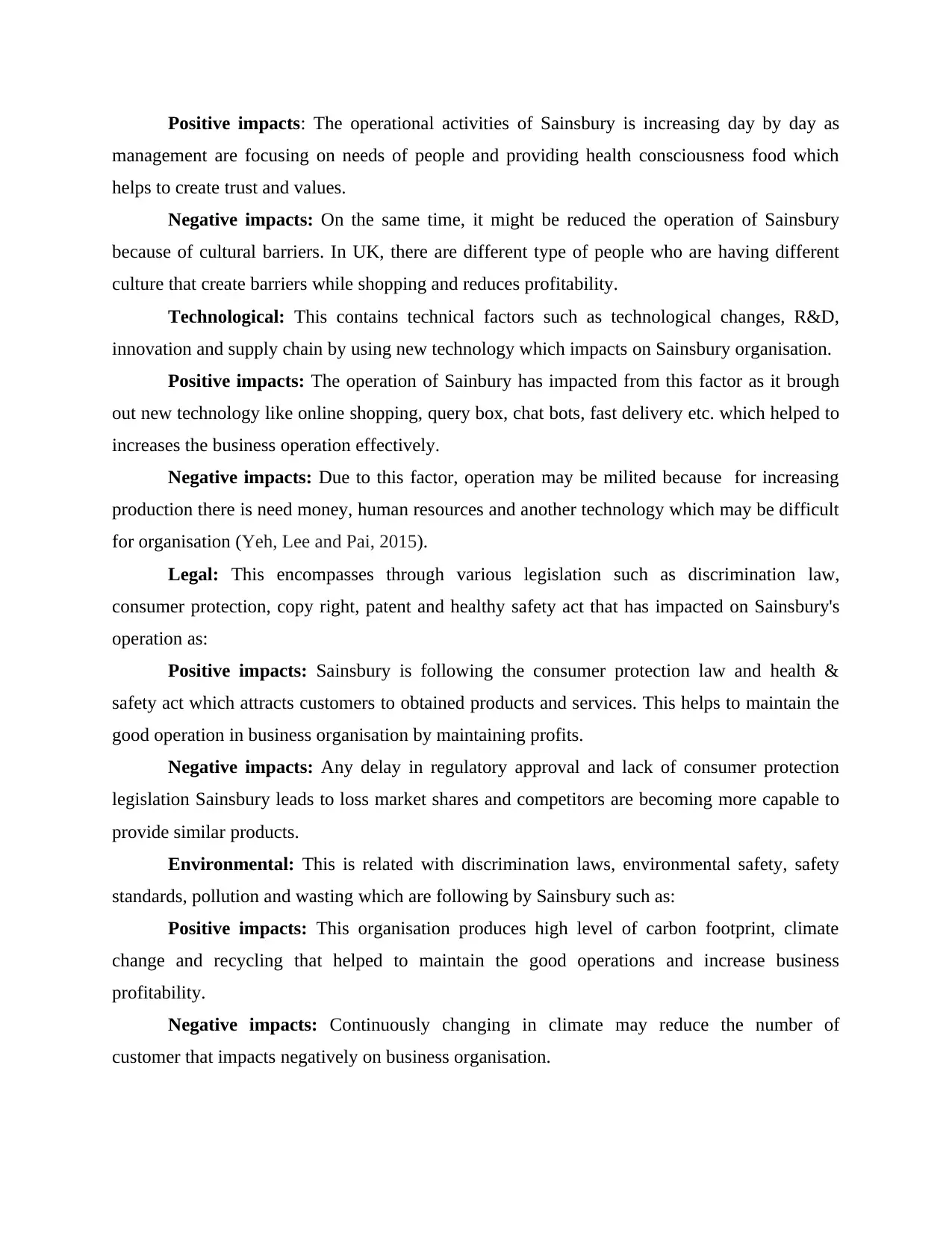
Positive impacts: The operational activities of Sainsbury is increasing day by day as
management are focusing on needs of people and providing health consciousness food which
helps to create trust and values.
Negative impacts: On the same time, it might be reduced the operation of Sainsbury
because of cultural barriers. In UK, there are different type of people who are having different
culture that create barriers while shopping and reduces profitability.
Technological: This contains technical factors such as technological changes, R&D,
innovation and supply chain by using new technology which impacts on Sainsbury organisation.
Positive impacts: The operation of Sainbury has impacted from this factor as it brough
out new technology like online shopping, query box, chat bots, fast delivery etc. which helped to
increases the business operation effectively.
Negative impacts: Due to this factor, operation may be milited because for increasing
production there is need money, human resources and another technology which may be difficult
for organisation (Yeh, Lee and Pai, 2015).
Legal: This encompasses through various legislation such as discrimination law,
consumer protection, copy right, patent and healthy safety act that has impacted on Sainsbury's
operation as:
Positive impacts: Sainsbury is following the consumer protection law and health &
safety act which attracts customers to obtained products and services. This helps to maintain the
good operation in business organisation by maintaining profits.
Negative impacts: Any delay in regulatory approval and lack of consumer protection
legislation Sainsbury leads to loss market shares and competitors are becoming more capable to
provide similar products.
Environmental: This is related with discrimination laws, environmental safety, safety
standards, pollution and wasting which are following by Sainsbury such as:
Positive impacts: This organisation produces high level of carbon footprint, climate
change and recycling that helped to maintain the good operations and increase business
profitability.
Negative impacts: Continuously changing in climate may reduce the number of
customer that impacts negatively on business organisation.
management are focusing on needs of people and providing health consciousness food which
helps to create trust and values.
Negative impacts: On the same time, it might be reduced the operation of Sainsbury
because of cultural barriers. In UK, there are different type of people who are having different
culture that create barriers while shopping and reduces profitability.
Technological: This contains technical factors such as technological changes, R&D,
innovation and supply chain by using new technology which impacts on Sainsbury organisation.
Positive impacts: The operation of Sainbury has impacted from this factor as it brough
out new technology like online shopping, query box, chat bots, fast delivery etc. which helped to
increases the business operation effectively.
Negative impacts: Due to this factor, operation may be milited because for increasing
production there is need money, human resources and another technology which may be difficult
for organisation (Yeh, Lee and Pai, 2015).
Legal: This encompasses through various legislation such as discrimination law,
consumer protection, copy right, patent and healthy safety act that has impacted on Sainsbury's
operation as:
Positive impacts: Sainsbury is following the consumer protection law and health &
safety act which attracts customers to obtained products and services. This helps to maintain the
good operation in business organisation by maintaining profits.
Negative impacts: Any delay in regulatory approval and lack of consumer protection
legislation Sainsbury leads to loss market shares and competitors are becoming more capable to
provide similar products.
Environmental: This is related with discrimination laws, environmental safety, safety
standards, pollution and wasting which are following by Sainsbury such as:
Positive impacts: This organisation produces high level of carbon footprint, climate
change and recycling that helped to maintain the good operations and increase business
profitability.
Negative impacts: Continuously changing in climate may reduce the number of
customer that impacts negatively on business organisation.
Paraphrase This Document
Need a fresh take? Get an instant paraphrase of this document with our AI Paraphraser
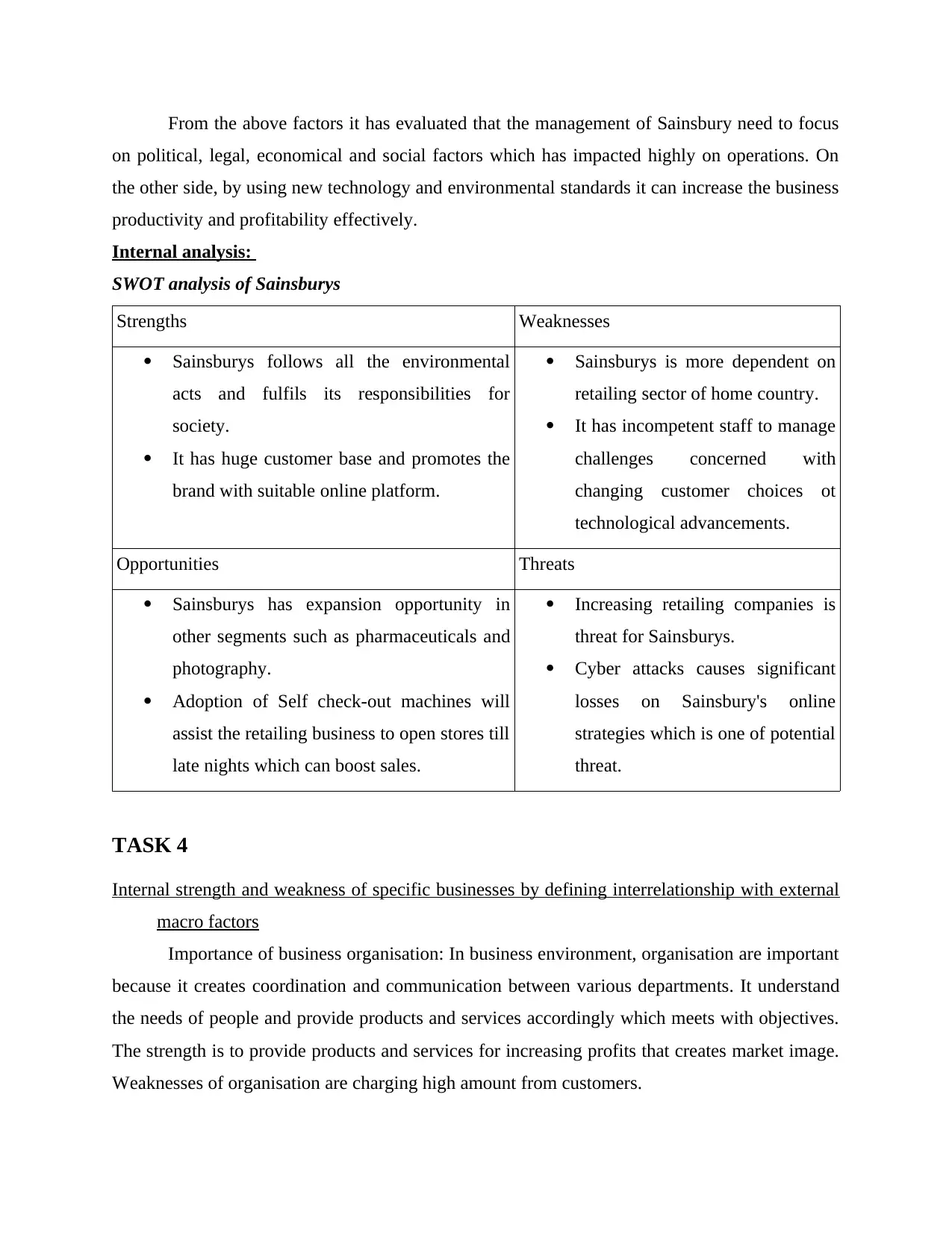
From the above factors it has evaluated that the management of Sainsbury need to focus
on political, legal, economical and social factors which has impacted highly on operations. On
the other side, by using new technology and environmental standards it can increase the business
productivity and profitability effectively.
Internal analysis:
SWOT analysis of Sainsburys
Strengths Weaknesses
Sainsburys follows all the environmental
acts and fulfils its responsibilities for
society.
It has huge customer base and promotes the
brand with suitable online platform.
Sainsburys is more dependent on
retailing sector of home country.
It has incompetent staff to manage
challenges concerned with
changing customer choices ot
technological advancements.
Opportunities Threats
Sainsburys has expansion opportunity in
other segments such as pharmaceuticals and
photography.
Adoption of Self check-out machines will
assist the retailing business to open stores till
late nights which can boost sales.
Increasing retailing companies is
threat for Sainsburys.
Cyber attacks causes significant
losses on Sainsbury's online
strategies which is one of potential
threat.
TASK 4
Internal strength and weakness of specific businesses by defining interrelationship with external
macro factors
Importance of business organisation: In business environment, organisation are important
because it creates coordination and communication between various departments. It understand
the needs of people and provide products and services accordingly which meets with objectives.
The strength is to provide products and services for increasing profits that creates market image.
Weaknesses of organisation are charging high amount from customers.
on political, legal, economical and social factors which has impacted highly on operations. On
the other side, by using new technology and environmental standards it can increase the business
productivity and profitability effectively.
Internal analysis:
SWOT analysis of Sainsburys
Strengths Weaknesses
Sainsburys follows all the environmental
acts and fulfils its responsibilities for
society.
It has huge customer base and promotes the
brand with suitable online platform.
Sainsburys is more dependent on
retailing sector of home country.
It has incompetent staff to manage
challenges concerned with
changing customer choices ot
technological advancements.
Opportunities Threats
Sainsburys has expansion opportunity in
other segments such as pharmaceuticals and
photography.
Adoption of Self check-out machines will
assist the retailing business to open stores till
late nights which can boost sales.
Increasing retailing companies is
threat for Sainsburys.
Cyber attacks causes significant
losses on Sainsbury's online
strategies which is one of potential
threat.
TASK 4
Internal strength and weakness of specific businesses by defining interrelationship with external
macro factors
Importance of business organisation: In business environment, organisation are important
because it creates coordination and communication between various departments. It understand
the needs of people and provide products and services accordingly which meets with objectives.
The strength is to provide products and services for increasing profits that creates market image.
Weaknesses of organisation are charging high amount from customers.
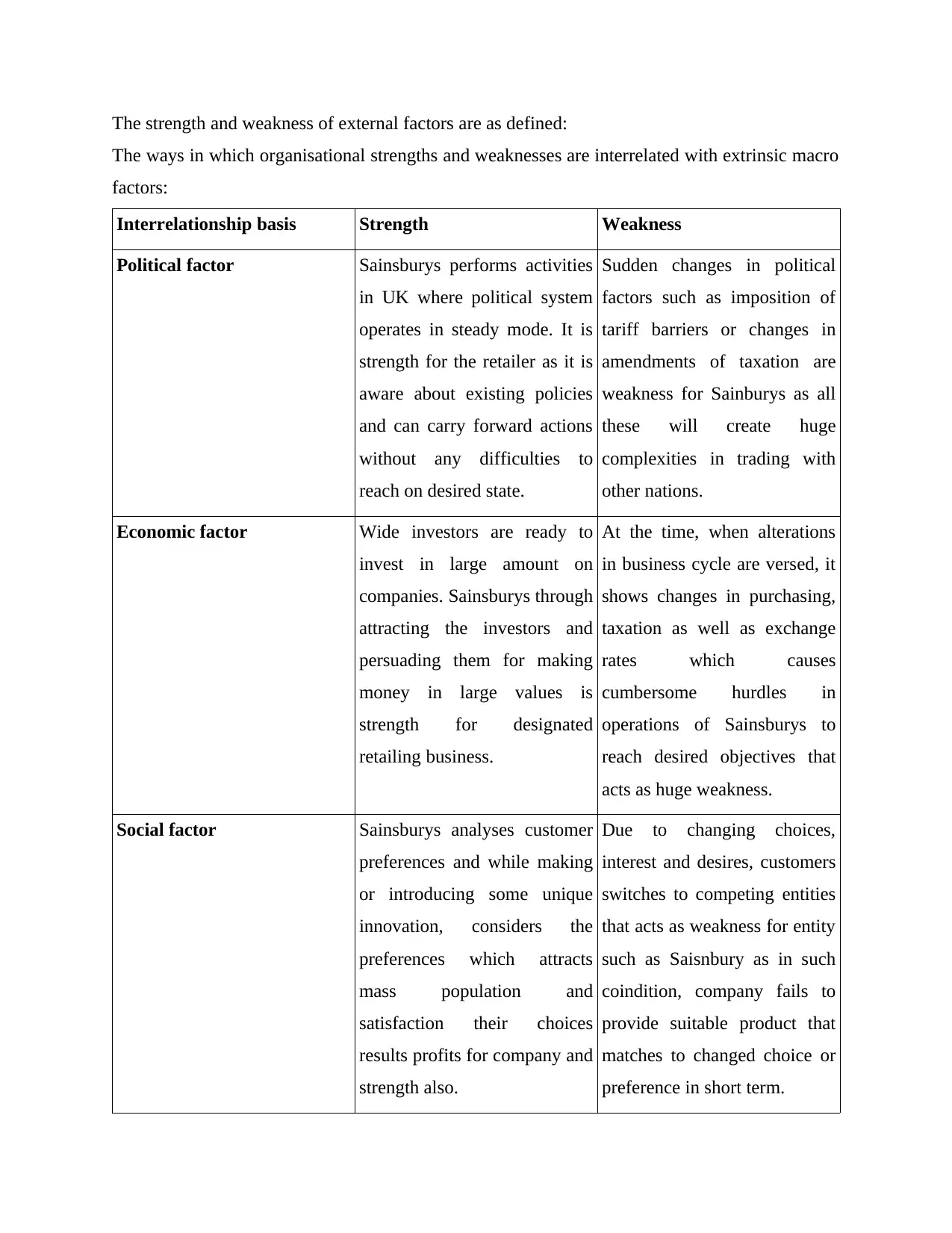
The strength and weakness of external factors are as defined:
The ways in which organisational strengths and weaknesses are interrelated with extrinsic macro
factors:
Interrelationship basis Strength Weakness
Political factor Sainsburys performs activities
in UK where political system
operates in steady mode. It is
strength for the retailer as it is
aware about existing policies
and can carry forward actions
without any difficulties to
reach on desired state.
Sudden changes in political
factors such as imposition of
tariff barriers or changes in
amendments of taxation are
weakness for Sainburys as all
these will create huge
complexities in trading with
other nations.
Economic factor Wide investors are ready to
invest in large amount on
companies. Sainsburys through
attracting the investors and
persuading them for making
money in large values is
strength for designated
retailing business.
At the time, when alterations
in business cycle are versed, it
shows changes in purchasing,
taxation as well as exchange
rates which causes
cumbersome hurdles in
operations of Sainsburys to
reach desired objectives that
acts as huge weakness.
Social factor Sainsburys analyses customer
preferences and while making
or introducing some unique
innovation, considers the
preferences which attracts
mass population and
satisfaction their choices
results profits for company and
strength also.
Due to changing choices,
interest and desires, customers
switches to competing entities
that acts as weakness for entity
such as Saisnbury as in such
coindition, company fails to
provide suitable product that
matches to changed choice or
preference in short term.
The ways in which organisational strengths and weaknesses are interrelated with extrinsic macro
factors:
Interrelationship basis Strength Weakness
Political factor Sainsburys performs activities
in UK where political system
operates in steady mode. It is
strength for the retailer as it is
aware about existing policies
and can carry forward actions
without any difficulties to
reach on desired state.
Sudden changes in political
factors such as imposition of
tariff barriers or changes in
amendments of taxation are
weakness for Sainburys as all
these will create huge
complexities in trading with
other nations.
Economic factor Wide investors are ready to
invest in large amount on
companies. Sainsburys through
attracting the investors and
persuading them for making
money in large values is
strength for designated
retailing business.
At the time, when alterations
in business cycle are versed, it
shows changes in purchasing,
taxation as well as exchange
rates which causes
cumbersome hurdles in
operations of Sainsburys to
reach desired objectives that
acts as huge weakness.
Social factor Sainsburys analyses customer
preferences and while making
or introducing some unique
innovation, considers the
preferences which attracts
mass population and
satisfaction their choices
results profits for company and
strength also.
Due to changing choices,
interest and desires, customers
switches to competing entities
that acts as weakness for entity
such as Saisnbury as in such
coindition, company fails to
provide suitable product that
matches to changed choice or
preference in short term.
⊘ This is a preview!⊘
Do you want full access?
Subscribe today to unlock all pages.

Trusted by 1+ million students worldwide
1 out of 17
Related Documents
Your All-in-One AI-Powered Toolkit for Academic Success.
+13062052269
info@desklib.com
Available 24*7 on WhatsApp / Email
![[object Object]](/_next/static/media/star-bottom.7253800d.svg)
Unlock your academic potential
Copyright © 2020–2025 A2Z Services. All Rights Reserved. Developed and managed by ZUCOL.




